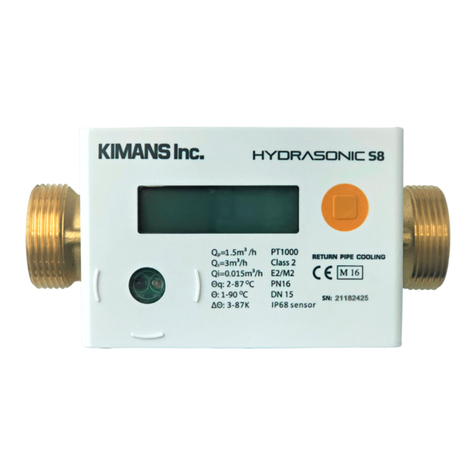1. General Information
1.1 Application and Function
This Hydrasonic S8 is designed for the measurement of consumed energy in a closed heating, cooling or heating
/cooling system.
1.2 Contents of the package
•Heat meter or heat/cooling meter, consisting of a calculator, a flow sensor and two temperatures
sensors, all permanently connected to each other
•Installation kit (depending on type)
•Installation and Operating Instructions
•Operating Instructions, Communication Interfaces S3(C) (with meters with an optional interface)
•Declaration of Conformity
1.3 Standards
•Valid standards for the application of heat meters: EN 1434, parts 1 –6; the Measuring instruments
•Directive 2014/32/EU, Annexes I and MI-004; and the relevant national verification regulations.
•For the selection, installation, commissioning, monitoring and maintenance of the instrument observe
the standard EN 1434 part 6, as well as the verification regulations PTB TR K8 + K9 for Germany (and any
relevant national verification regulations in other countries).
•National regulations for the consumption measurement of cooling must be observed.
•The technical regulations for electrical installations must be observed.
•This product fulfils the requirements of the European Council Directive on Electromagnetic Compatibility
(EMC Directive) 2014/30/EU.
•The identification plate of the instrument and the seals must not be removed or damaged otherwise the
guarantee and the approved application of the instrument are no longer valid!
•To achieve measurement stability of the meter it is necessary that the water quality meets the
requirements of the AGFW-recommendation FW-510 and the document VDI (Association of German
Engineers) VDI 2035.
•The heat meter left the factory in conformance with all applicable safety regulations. All maintenance
and repair work are to be carried out only by qualified and authorized technical personnel.
•Instruments with activated radio function are not allowed on air freight.
•The correct installation point in the system must be chosen: inlet or outlet flow.
•The temperature sensor cables and the cable between the calculator and flow sensor must not be
kinked, rolled up, lengthened or shortened.
•To clean the heat meter (only if necessary) use a slightly moist cloth.
•To protect against damage and dirt the heat meter should only be removed from the packaging directly
before installation.
•If more than one heat meter is installed in one unit, care must be taken to ensure that all meters have
the same installation conditions.
•All specifications and instructions listed on the data sheet and in the application notes must be adhered,
further information can be obtained at www.kimans.com




























